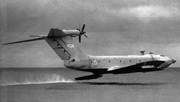E-Archive
Off the Beaten Track
in Vol. 11 - May Issue - Year 2010
Sailing High

Fig 1: Normal air pressure

Fig 2: High air pressure

Caspian Sea Monster

Russian A-90 Orlyonok - 125 tons
Now here’s an interesting question: when is a ship not a ship? Or, if you prefer, when is an aircraft not really an aircraft? These questions come to mind when considering a category of ships which were created in the 1940’s and which almost nobody has ever heard of…
Airplane pilots coming in for a landing experience a strange effect just a few moments before touchdown. The aircraft doesn’t seem to want to touch ground and the final glide goes on and on before the wheels finally hit the asphalt. This phenomenon is caused by the cushion of air which gets trapped between wing and runway and is known as ground effect or wing-in-ground effect. The cushion of air gets compressed between the two surfaces, thereby increasing in pressure and giving more lift to the wings. This effect occurs at an altitude above ground approximately equal to the aircraft’s wingspan and increases as the wings approach the ground, reaching its maximum at a height of about one half the wingspan. At this height lift can increase by as much as 40%.
The two images here below show the distribution of air pressure around a wing, where the areas of higher pressure are indicated in red. Figure 1 shows a wing at normal cruising altitude, whereas figure 2 shows a wing experiencing ground effect, when the area of high-pressure air is noticeably larger and leads to a much better lift/drag ratio.
Shortly before the Second World War, it was realized that the wing-in-ground effect could be used to design craft which could fly over a flat surface with much greater haulage capacity compared to conventional aircraft.
What does all this have to do with ships? Since they need a perfectly flat surface in order to make use of the ground effect, the practical use of these vehicles is limited to large bodies of water such as lakes, seas and oceans. Furthermore, as they are designed with shorter and wider wings compared to airplanes and they could not sustain flight without the aid of the ground effect, in 2005 these vehicles were classified by the International Maritime Organization under the category of ships. This type of craft has come to be known as “ground effect vehicle (GEV)” or “wing-in-surface-effect ship (WISE)”, since they are used mostly over water.
The largest and fastest WISE ship ever built was developed in the U.S.S.R. during the Cold War and was nicknamed the “Caspian Sea Monster”. It weighed 550 tons and flew over the water at an altitude of twenty meters, reaching a top speed of 560 km/h.
Other countries went on to develop their own designs, primarily for military applications, but funding dried up after the Cold War and subsequent production was limited to recreational uses or for transportation of goods.
In recent years, there has been a revival in interest and in 2007 Russia, which has maintained its technological edge in this field, announced the development of an ultra-heavy amphibious transport plane called the Be-2500. It will have a takeoff weight of about 2,500 tons with a payload of almost 1,000 tons. Wingspan is 125 meters, length is 115 meters and height 29 meters, with a cruising speed in ground effect of 450 km/h. It will also be capable of flying at altitude without ground effect at a speed of 770 km/h.
By comparison, a Boeing 747 is about 70 meters long and almost 20 meters high, with a wingspan of about 64 meters.
By Giovanni Gregorat, Contributing Editor MFN & Sales Manager, Pometon Abrasives
Author: Giovanni Gregorat



























